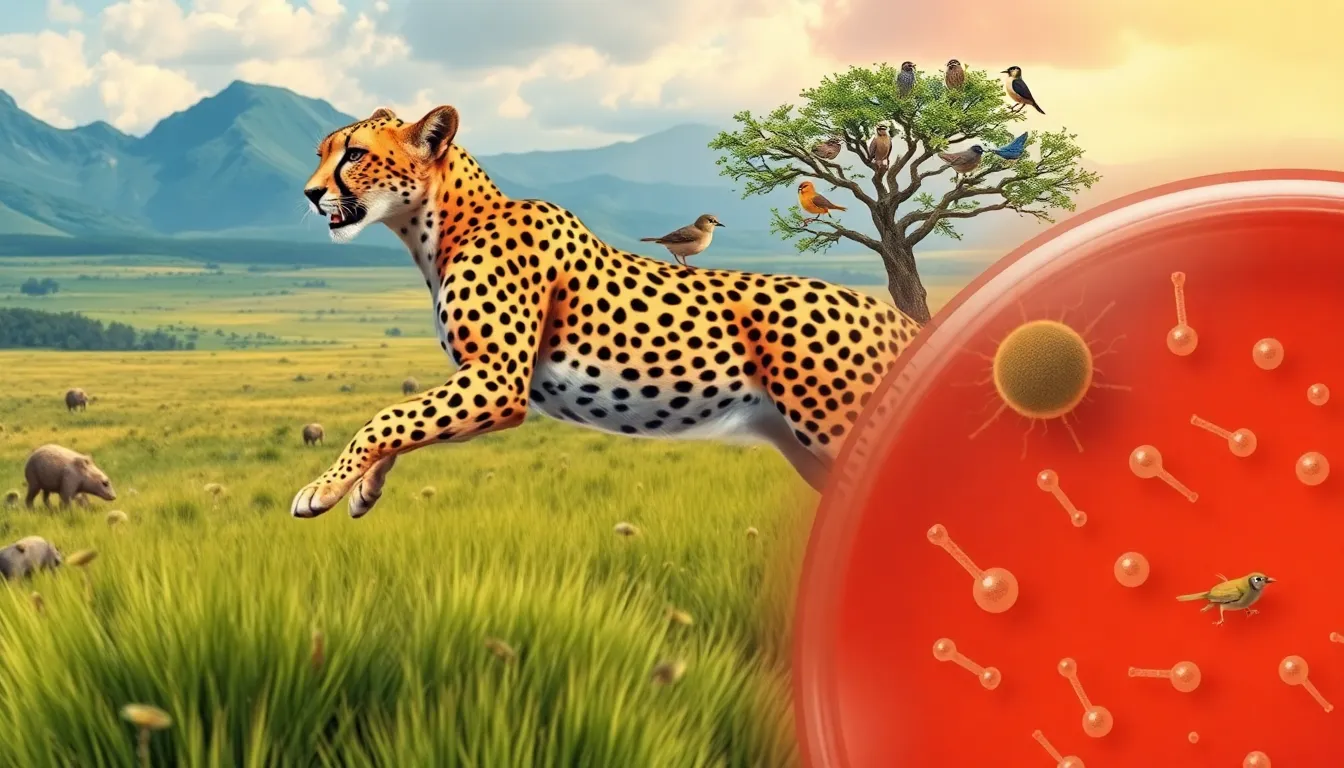Table of Contents
ToggleEvolution isn’t just about dinosaurs and Darwin; it’s a wild ride through time that shapes every living thing today. From the tiniest microbes to majestic elephants, understanding evolution patterns reveals how life adapts and thrives in ever-changing environments. It’s like nature’s version of a reality TV show—only with more drama and fewer commercial breaks.
Overview of Evolution Patterns
Evolution patterns vary significantly across the tree of life. These patterns showcase diverse adaptations among organisms. Gradualism describes the slow, steady transformation of species over long periods. This approach highlights the incremental changes that take place within populations.
Punctuated equilibrium, on the other hand, illustrates periods of rapid change followed by stability. This model suggests that evolution happens in bursts due to environmental factors. Both concepts highlight the dynamic nature of evolution.
Adaptive radiation occurs when species diversify rapidly to fill various ecological niches. An example of adaptive radiation can be seen in Darwin’s finches, which developed specialized beaks suitable for different food sources. Convergent evolution also demonstrates how unrelated species can evolve similar traits in response to comparable environmental challenges. This pattern emphasizes the importance of environmental pressures in shaping species.
Another significant pattern involves coevolution, which refers to the reciprocal influence of two species on each other. This process plays a vital role in predator-prey dynamics and symbiotic relationships. For instance, flowering plants and pollinators often evolve together, ensuring mutual benefit.
Evolutionary patterns are influenced by genetic, environmental, and ecological factors. Genetic drift can cause random changes in gene frequencies, impacting small populations especially. Natural selection drives the survival of the fittest, favoring traits that enhance reproductive success. These mechanisms illustrate the complexity of evolutionary processes.
Understanding evolution patterns provides insights into the history of life on Earth. Each pattern adds to the rich tapestry of biological diversity that characterizes our planet. Observing how species adapt and evolve underscores the profound effects of changing environments.
Key Factors Influencing Evolution Patterns

Multiple factors drive evolution patterns, each contributing uniquely to the way species adapt and diversify over time.
Natural Selection
Natural selection is the process where organisms better adapted to their environment tend to survive and reproduce. Strong traits become more common within a population, while less advantageous traits diminish. This mechanism plays a critical role in shaping species over generations. For instance, faster cheetahs tend to catch prey more efficiently, leading to greater reproductive success. Environmental changes directly influence which traits are favorable, ensuring that evolution remains a dynamic, responsive system.
Genetic Drift
Genetic drift refers to random changes in allele frequencies within a population. Smaller populations are especially vulnerable to significant genetic drift, affecting their genetic diversity. Some traits may disappear entirely due to randomness rather than natural selection. An example includes the founder effect, where a small group establishes a new population, carrying only a fraction of the genetic diversity. Over time, this can lead to distinct evolutionary pathways, highlighting the unpredictable role of chance in evolution.
Mutation
Mutation involves changes in an organism’s DNA that can introduce new genetic variants. While many mutations are neutral or harmful, some can confer advantages under certain conditions. Beneficial mutations may result in enhanced survival or reproductive success, driving evolution forward. For example, a mutation in certain bacteria can confer antibiotic resistance, allowing those bacteria to thrive in treated environments. This underscores the importance of mutation in the long-term evolutionary process, as it provides the raw material for natural selection to act upon.
Types of Evolution Patterns
Diverse evolution patterns illustrate the varied ways species adapt and change over time. Each pattern reveals unique mechanisms driving evolutionary processes.
Divergent Evolution
Divergent evolution occurs when related species develop different traits and characteristics due to adaptations to distinct environments. This pattern showcases how a common ancestor can give rise to varied descendants. An example of this can be seen in the evolution of mammals, including whales and land mammals, which evolved different traits while sharing a common lineage. As environments change, divergent evolution highlights the significance of natural selection in shaping the diversity of life forms.
Convergent Evolution
Convergent evolution describes the process where unrelated species develop similar traits in response to comparable environmental challenges. This phenomenon emphasizes the role of adaptation over common ancestry. One well-known example includes the wings of bats and birds. Despite their different evolutionary backgrounds, both developed wings to facilitate flight. Such similarities underline how environmental pressures can shape the evolution of distinct species in similar ways.
Parallel Evolution
Parallel evolution occurs when species with a common ancestor evolve similar traits independently as they adapt to analogous environments. This often happens in closely related species, reflecting how similar selection pressures can lead to comparable adaptations. An example can be observed in the evolution of marsupial and placental mammals, which developed analogous traits, such as body forms and reproductive methods, while diverging in geographical regions. Such occurrences underscore the influence of environmental factors on the evolutionary pathways of closely related organisms.
The Role of Environment in Evolution Patterns
The environment plays a crucial role in shaping evolution patterns. Various elements like climate, geography, and available resources impact the adaptability of species. Species face distinct pressures based on their habitats, influencing their evolutionary trajectory.
Natural selection operates within these environments, favoring traits that enhance survival. Organisms better suited to their surroundings thrive and reproduce. This process leads to gradual changes over time, as seen in species adapting to extreme climates, such as desert and polar habitats.
Geographical isolation introduces unique pressures. When populations become separated, they experience distinct environmental conditions. Such isolation can lead to divergent evolution, where related species adapt to different niches, exemplified by Darwin’s finches adapting to various food sources on the Galápagos Islands.
Different environments can also lead to convergent evolution. Unrelated species often develop similar traits when facing comparable challenges. The wings of bats and birds illustrate this phenomenon, as both provide the ability to fly, despite differing ancestry.
Coevolution further demonstrates the intricate connection between species and their environments. Many interactions between plants and pollinators co-evolve, resulting in mutual adaptations. This interplay highlights how species respond to one another while navigating environmental changes.
Lastly, the ever-shifting environment prompts ongoing evolution. New challenges, from climate changes to human impact, continually shape species. Understanding these dynamics reveals the complexity and interdependence of life on Earth, showcasing the profound influence of the environment on evolutionary patterns.
Understanding evolution patterns reveals the intricate dance of life adapting to ever-changing environments. These patterns showcase the dynamic interactions between species and their surroundings. From gradual shifts to rapid changes and the complex relationships formed through coevolution, the story of evolution is far from static.
As researchers continue to unveil the nuances of evolutionary processes, it becomes clear that life on Earth is a testament to resilience and adaptability. The ongoing journey of evolution not only enriches our knowledge of biology but also highlights the profound connections among all living organisms. Embracing this complexity deepens appreciation for the natural world and its remarkable capacity for change.







